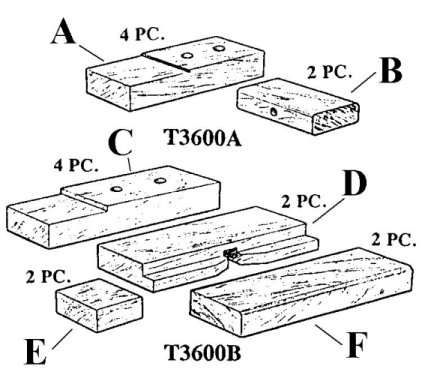26-27 Body Blocks
Below are instructions for installing Body Block Provided by Bill Schatz.
Refer to the picture below while reading the instructions.

1.)
Using the driver's side as reference point: Block D goes up in the
rail space behind the rear wheel well (as it were since isn't a deep well).
The dado that goes all the way through the block faces outward as you put it
up in the space lengthwise. The dado should line up so you can look down
through the hole in the trunk and see a clear shot through the dado where you put
the long body bolt that bolts the body to the frame. Immediately next to
block D, you shove block F up in the space lengthwise. Block F is there to
tighten up block D so block D doesn't slide around. If they are
reproduction blocks you may have to shave a tiny bit off to get F to slide
up next to D. When you put D up in there, the rabbet should be facing
outwards because it needs to clear the lip of the inside of the wheel well
where the outside sheet metal folds inward.
2.) Blocks C for the coupe and roadster as original blocks measure exactly
8.5". The other set for the touring and tudor measure 7.5". However, if
you notice: the important thing is placement so the holes line up with the
body bolt holes. Also, the rabbet is there to clear the body metal. I
think you could use either set with either cars, unless the holes don't
match up. I have seen instances where one long board is rabbeted on both
ends and holes are drilled where the body bolts come through and that was used
as the "block" running the full length of the rail. Remember, these sit
directly under those two "rails" that run lengthwise on both sides of the
tray that sits under the seat and thus sit on top of the body bolt tabs that
are on the frame of the car when you set the body back on the frame.
3.) Block E is inserted in the space underneath the body just directly in
front of the body bolt tab that is attached to the body. Ford used a wood
screw to hold in place, but that angled "kick plate" with the big round hole
in it on the inside of the body (where the drivers left foot would rest on
the driver's side as a point of reference - same type angle plate on
passenger side) was welded onto the body after the block was screwed in. I
would shove it up in there and use a shim to keep it tight. Once you set
the body back on the car it shouldn't move around. When you get the body
secured on the frame with the body bolts you put a wood screw up into block
E (on both sides) to hold the splash aprons in place. My guess is you
really don't need block E, except it does keep the splash aprons anchored in
front.
Sizes: Provided by Bob Frink
The blocks are 8 1/4" x 1 3/8" x 2 1/2",
with a 1/8" deep dado, 2 1/2" long, on the 2 1/2" side. On two
blocks, there is a 1/2" hole drilled through the 2 1/2" face, 1
3/4" from the end without the dado. The other two blocks, the hole is 3
3/4" from the end.
These are the blocks under the main body. There are also blocks inside the
subframe, under the turtledeck. There is a fitted block, and a plain block to
wedge it in place, which is held in place with two wood screws from the inside
rail of the subframe. The fitted block is 8" x 3 1/4" x 1", with
a 1/2" deep dado 1/4" wide, along the 8" edge. There is a
5/8" x 5/8" dado across the center of the 3 1/4" face, that the
mount bolt goes through.
The fitted piece fits in the recess, with the lip of the dado sticking out
through the gap between the sides of the subframe rails. The plain block slips
alongside, and wedges it in place.

